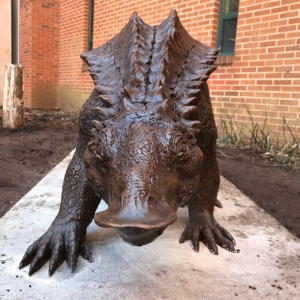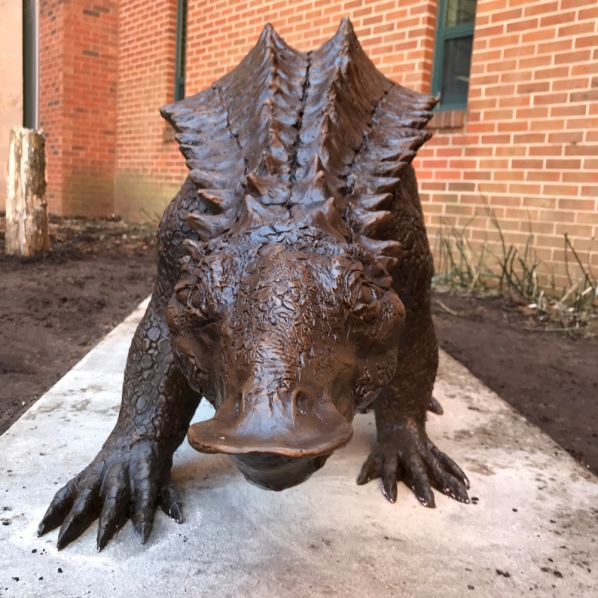Appalachian State University faculty members, Dr. Andrew Heckert, Dr. Lauren Waterworth and Travis Donovan have collaborated with geology and art students over the last four years to sculpt “Archie” the aetosaur based on a handful of prehistoric bones unearthed near Raleigh, North Carolina. As Archie has finally come home to rest in a habitat installed on campus for this one-of-a-kind sculpture, we take a look at the process of his creation.

Caption: Artist’s reconstructions of Gorgetosuchus based on the preserved fossils and comparison to closely related aetosaurs. Reconstruction by Matt Celeskey.
The project began when a team led by Dr. Andrew Heckert, professor, Department of Geological and Environmental Sciences, published a new species of aetostaur called Gorgetosuchus pekinensis from North Carolina in 2015. Heckert analyzed this reptilian creature and the actual fossils are in the permanent collections of the North Carolina Museum of Natural Sciences. Dr. Lauren Waterworth, Department of Geological and Environmental Sciences, brainstormed a way to bring Archie to life on Appalachian’s campus and created a collaboration with the Department of Art through Travis Donovan, assistant professor and sculptor, to turn her vision into a tangible reality. In spring 2016, "Archie" the Aetosaur was modeled by art department faculty and students from the actual fossil record.

Caption: (Left) Initial aetosaur model created using digital sculpting software. Image provided by Travis Donovan. (Right) The digital model was adjusted based on resources derived from the fossil record data and paleo-illustration. Image provided by Travis Donovan.
“This is the largest, and most accurate, aetosaur sculpture in the northern hemisphere and one of the best in the world,” said Heckert.
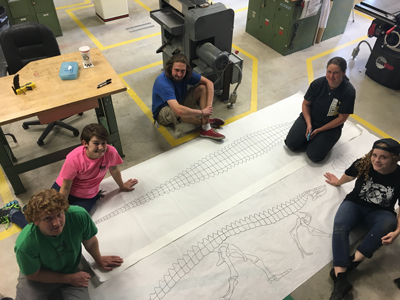
Caption: Advanced Sculpture students scale up all skeletal paleo-illustrations, in preparation for constructing the accurate full scale model. Pictured from left to right Daniel Desmarais, Hunter Hill, Matt LeBlanc*, Rebecca Bremer and McKenzy Culbertson. Photo by Travis Donovan.
Donovan, along with six of his advanced sculpting students - Rebecca Bremer ’17, Mars Hill, North Carolina; McKenzy Culbertson ’17, Waxhaw, North Carolina; Daniel Desmarais, Banner Elk, North Carolina; Hunter Hill ’17, Boone, North Carolina; Matt LeBlanc* ’18, Hermantown, Minnesota and Rebecca Hurwitz ’18, Poolesville, Maryland – created a life size sculpture of the aetosaur. Matt Celeskey, a paleontological artist and exhibit designer from New Mexico, came up with the original sketch for Archie. Celeskey then put the sketch into computer-aided design software (CAD) to make a 3D model for the sculpture. Archie’s “armor” was constructed out of insulated foam, plasticine and clay. After construction, Archie was sent to Inferno Art Foundry, a bronze foundry in Atlanta, to be cast in bronze and has now been placed in The Fred Webb Jr. Outdoor Geology Laboratory - Interactive Rock Garden outside of Rankin Science.  Caption: (Left) Appalachian’s aetosaur “Archie” took form from line art and a simple steel frame. Photo by Travis Donovan. (Right) Pictured is another step bridging digital fabrication methods and traditional sculpting techniques. This is the finished digital model converted into planes to be cut in high density foam on a CNC milling machine. Photo by Travis Donovan.
Caption: (Left) Appalachian’s aetosaur “Archie” took form from line art and a simple steel frame. Photo by Travis Donovan. (Right) Pictured is another step bridging digital fabrication methods and traditional sculpting techniques. This is the finished digital model converted into planes to be cut in high density foam on a CNC milling machine. Photo by Travis Donovan.
“The detail of the final bronze piece is immaculate. It looks so similar to what the actual clay-model piece was. You can still see the fingerprints from the students who were working on that process,” said Donovan.
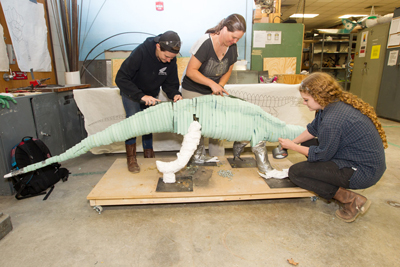
Caption: Appalachian students create a steel and foam armature based on a paleo-illustration of an aetosaur. The armature serves as a basic structure scaled to the general size of the imagined aetosaur. Pictured from left to right, Hunter Hill, Rebecca Bremer and McKenzy Culbertson. Photo by Marie Freeman.
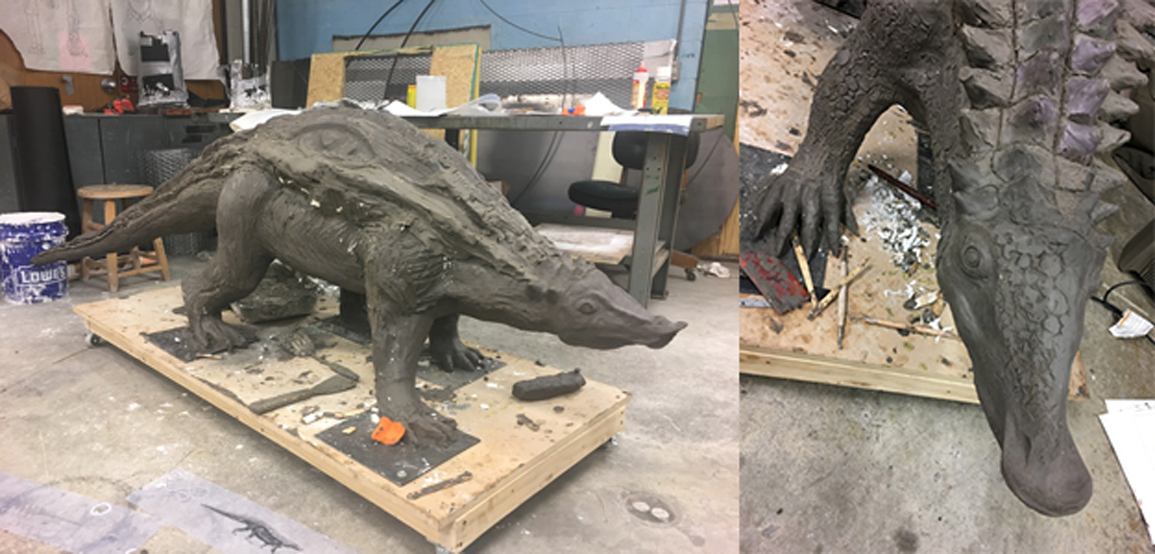
Caption: (Left) “Archie” begins to take shape as the foam and steel armature is covered in oil based clay. Photo by Dr. Lauren Waterworth. (Right) Details and textures are carved into the surface of the clay with reference to the fossil record data as well as emulating the skin and muscle of crocodiles, some of Archie’s present day relatives. Photo by Travis Donovan.
The funds take Archie from Waterworth’s concept to a plasticine model initially came from a University Research Council grant and additional funds to cast Archie in bronze were generously contributed by corporate and individual donors. More than 50 supporters came together to make this vision a reality. The Fred Webb Jr. Outdoor Geology Laboratory - Interactive Rock Garden, where Archie now lives, was named in honor of Dr. Fred Webb Jr, the first and longest-serving chair of the department upon his retirement.

Caption: An image of Archie taken through a collaboration with Commercial Photography students in their large scale production studio. Photo by Andrew Caldwell.
The aetosaur habitat and sculpture will help to educate future generations of Appalachian students and members of the community about North Carolina’s landscape and the evolution of creatures from the Triassic period. To learn more about outreach and engagement opportunities, contact the Department of Geological and Environmental Sciences at mckinneymuseum@appstate.edu or visit https://earth.appstate.edu/outreach.

Caption: Archie arrives on campus from the foundry, being unloaded by members of the physical plant outside Rankin Science. Photo by Dr. Lauren Waterworth
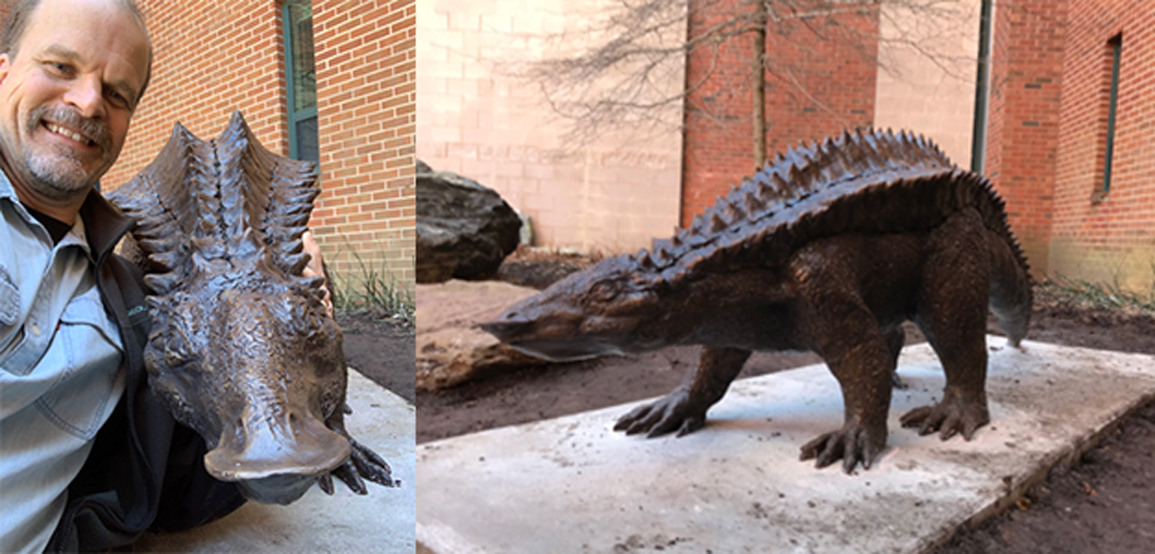
Caption: (Left) Dr. Andrew Heckert with Archie in his new habitat located on Appalachian’s campus. Photo by Dr. Andrew Heckert. (Right) Archie officially installed in his permanent home located in the Fred Webb Jr. Outdoor Lab and Rock Garden outside Rankin Science on Appalachian’s campus. Photo by Dr. Lauren Waterworth
About Dr. Andrew Heckert
Heckert is a professor of geology and director of the McKinney Geology Teaching Museum. He won the College of Arts and Sciences 2015 Donald W. Sink Outstanding Scholar Award, the 2017 Undergraduate Research Mentorship Excellence Award and received the N.C. Geological Survey’s Outstanding Earth Science Educator Award in 2011.
About Travis Donovan
Donovan received a BFA in Sculpture from Appalachian State University in 2004. He became a North Carolina Artists Fellow after receiving his MFA from the University of North Carolina in 2011. He is currently an assistant professor of sculpture and area coordinator at Appalachian State University.
About Dr. Lauren Waterworth
Waterworth graduated from the Appalachian State Geology Department in 2001. She has a Master's Degree from Texas A&M University and a Juris Doctorate from Tulane University Law School with a certificate in Environmental Law. Her focus is on Clean Water Act enforcement issues in the southern Appalachians. Waterworth joined the faculty of Appalachian State University in January of 2011.
*Although deceased, LeBlanc's contributions to this project are notable and appreciated.
###
About the Department of Geological and Environmental Sciences
Located in Western North Carolina, Appalachian State University provides the perfect setting to study geological and environmental sciences. The Department of Geological and Environmental Sciences provides students with a solid foundation on which to prepare for graduate school or build successful careers as scientists, consultants and secondary education teachers. The department offers six degree options in geology and two degree options in environmental science. Learn more at https://earth.appstate.edu.
About the Department of Art
One of seven departments housed in the College of Fine and Applied Arts, the Department of Art at Appalachian State University prepares students to explore art, identity, expression and creative problem-solving while challenging them to go beyond their previous limits by discovering new connections to culture. The department offers degrees in art and visual culture, art education, graphic design, studio art, commercial photography and graphic communications management, with minors in art history, studio art, commercial photography and graphic arts and imaging technology. Learn more at http://www.art.appstate.edu.
About the College of Fine and Applied Arts
Appalachian State University’s College of Fine and Applied Arts is a dynamic and innovative group of seven academic departments, bringing together a variety of perspectives, experiences and real-world education to provide unique opportunities for student success. The college has more than 3,000 undergraduate and graduate majors. Its departments are Applied Design, Art, Communication, Military Science and Leadership, Sustainable Development, Sustainable Technology and the Built Environment, and Theatre and Dance. Learn more at https://faa.appstate.edu.
About the College of Arts and Sciences
The College of Arts and Sciences is home to 16 academic departments, one stand-alone academic program, two centers and one residential college. These units span the humanities and the social, mathematical and natural sciences. The College of Arts and Sciences aims to develop a distinctive identity built upon our university's strengths, traditions and unique location. The college’s values lie not only in service to the university and local community, but through inspiring, training, educating and sustaining the development of its students as global citizens. There are approximately 6,100 student majors in the college. As the college is also largely responsible for implementing Appalachian's general education curriculum, it is heavily involved in the education of all students at the university, including those pursuing majors in other colleges. Learn more at https://cas.appstate.edu.
Aug. 14, 2020
By Maddie Seehafer in collaboration with Ellen Gwin Burnette
BOONE, N.C.
